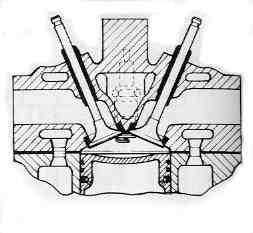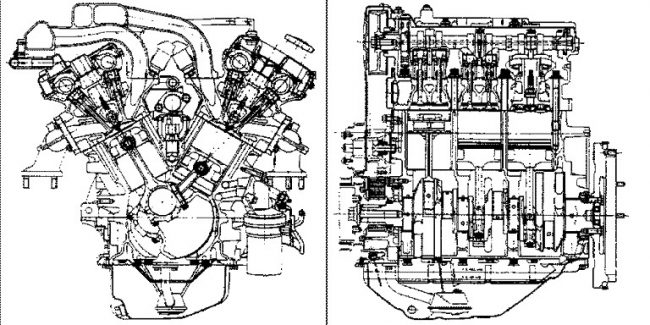
About Mazda K-series engines
Content
The K series from Mazda are V-engines with a displacement range from 1,8 to 2,5 liters.
The developers of this line of engines set themselves the goal of designing a power unit that would be characterized by high performance, providing good acceleration, while having low fuel consumption and meeting all environmental safety requirements.
In addition, it was decided to equip the K-series engines with a pleasant sound that describes the full power of the heart of the car.
Mazda K-series engines were produced from 1991 to 2002. This line includes the following modifications of motors:
- K8;
- KF;
- KJ-GROUND;
- KL;
All engines of the presented series have a V-shaped version with an angle of inclination of the cylinder heads of 60 degrees. The block itself was made of aluminum, and the cylinder head included two camshafts.  Engines of the K series as a result of such a design, according to the developers, should have had the following advantages:
Engines of the K series as a result of such a design, according to the developers, should have had the following advantages:
- Low fuel consumption with low emissions of harmful substances into the atmosphere;
- Excellent acceleration dynamics, accompanied by a pleasant sound of the motor;
- Despite the fact that they have a V-shaped design with six cylinders, the engines of this series were supposed to be the lightest and most compact in their class;
- Possess high rates of strength and durability even under increased loads.
Below is the "Pentroof" combustion chamber, which is equipped with the entire range of K-series engines:
K series engine modifications
K8 - is the smallest power unit from this series and at the same time the first engine that was installed on a production car. The engine capacity is 1,8 liters (1845 cm3). Its design includes 4 valves per cylinder, as well as the following systems:
- DOHC is a system consisting of two camshafts located inside the cylinder heads. One shaft is responsible for the operation of the intake valves, and the second for the exhaust;
- VRIS is a system that changes the length of the intake manifold. It allows you to make power and torque more optimized, as well as improve fuel efficiency.
The principle of operation of the VRIS system is shown in the following figure:
Two configurations of this engine were produced - the American (K8-DE), which produces 130 hp. and Japanese (K8-ZE) for 135 hp
KF- the engine of this model has a volume of 2,0 liters (1995 cm3) and was produced in several versions. The KF-DE version, according to various power tests, had from 140 to 144 hp. But his Japanese colleague KF-ZE had 160-170 hp at his disposal.
KJ-ZEM - this power unit, with a displacement of 2,3 liters, was once considered one of the most innovative among all engines from Mazda. This happened because he worked on the principle of the Miller Cycle, the essence of which was to use a supercharger. It contributed to a more efficient compression ratio, which made it possible to significantly increase the power output of this six-cylinder V-twin engine. The supercharger itself is made in the form of a twin-screw system that controls boost. All this allowed the engine, with a working volume of 2,3 liters, to produce power of 217 hp and a torque of 280 N * m. KJ-ZEM was rightfully included in the list of the best engines for 1995 - 1998.
KL - the engine family of this series had a working volume of 2,5 liters (2497 cm3). There are only three variations of this power unit - the Japanese version of the KL-ZE, which has 200 hp; American KL-DE, which is the world version and owns from 164 to 174 hp. In addition, outside the United States, the KL-03 version was produced, which was installed on Ford Probes. It is worth noting that in 1998, an improved version of the KL, referred to as the KL-G626, was introduced on the Mazda 4. The intake system was modified, a cast crankshaft was used to reduce the rotating mass, and the ignition coil from Ford EDIS was used for the first time.
Below is a sectional diagram of the KL engine:
For reference! The KL series of engines was equipped with the VRIS system, which the developers considered the most important technology of the new generation. Its essence was that the volume and length of the resonant chamber in the exhaust manifold changed due to rotary valves. This made it possible to achieve the most optimal ratio of power and torque at any engine speed!
Main characteristics
For more information and maximum convenience, all the most important characteristics of the K-series engine family are summarized in the table below:
| K8 | KF | KJ-ZEM | KL | |
|---|---|---|---|---|
| A type | 4-stroke, petrol | 4-stroke, petrol | 4-stroke, petrol | 4-stroke, petrol |
| Volume | 1845 sm3 | 1995 sm3 | 2254 cm 3 | 2497 sm3 |
| Diameter and piston stroke, mm | 75 × 69,6 | 78 × 69,6 | X 80,3 74,2 | 84,5 × 74,2 |
| Valve mechanism | DOHC belt driven | DOHC belt driven | DOHC belt driven | DOHC belt driven |
| Number of valves | 4 | 4 | 4 | 4 |
| Fuel consumption, l / 100 km | 4.9 – 5.4 | 05.07.2010 | 5.7 – 11.8 | 5.8 – 11.8 |
| Compression ratio | 9.2 | 9.5 | 10 | 9.2 |
| Maximum power, HP / rev. min | 135 / 6500 | 170 / 6000 | 220 / 5500 | 200 / 5600 |
| Maximum torque, N * m / rev. min | 156/4500 | 170/5000 | 294 / 3500 | 221/4800 |
| Overall dimensions (length x width x height), mm | 650x685x655 | 650x685x660 | 660h687h640 | 620x675x640 |
| Fuel used | AI-95 | AI-98 | AI-98 | AI-98 |
It should also be added that the resources of engines in the K series are different and depend on the volume, as well as the presence of a turbocharger. So, for example, the approximate resource of the K8 model will be 250-300 thousand km. The viability of KF engines can reach 400 thousand km, but the situation with KJ-ZEM is a little different.
This engine is equipped with a turbocharger, which increases power performance, while sacrificing its reliability. Therefore, its mileage is about 150-200 thousand km. If we talk about KL-engines, then their resource reserve reaches 500 thousand km.
For reference! Any engine has its own serial number, including the K series from Mazda. In these internal combustion engines in all its modifications, information about the number is placed on a special platform, which is located on the right side of the engine, closer to the pallet. It should be noted that the engine serial number can also be duplicated on one of the cylinder heads, at the bottom of the front passenger door, under the windshield. It all depends on the make of the car!
Cars on which K-series engines were installed
The list of cars that were equipped with this line of engines is summarized in the following table:
| K8 | Mazda MX-3, Eunos 500 |
| KF | Mazda Mx-6, Xedos 6, Xedos 9, Mazda 323f, Mazda 626, Eunos 800 |
| KJ-ZEM | Mazda Millenia S, Eunos 800, Mazda Xedos 9 |
| KL | Mazda MX-6 LS, Ford Probe GT, Ford Telstar, Mazda 626, Mazda Millenia, Mazda Capella, Mazda MS-8, Mazda Eunos 600/800 |
Advantages and disadvantages of K series engines
Compared to previous engine lines, this series features a number of innovative developments, which include changes to the combustion chambers, intake and exhaust systems, electronic control, increased reliability and noise reduction.
In addition, the developers managed to achieve excellent acceleration dynamics with relatively low fuel consumption and low emissions of harmful substances into the atmosphere. Perhaps the only significant drawback, as with most V-shaped engines, is increased oil consumption.
Attention! Japanese engines, including those from Mazda, are distinguished by their reliability and durability. With timely maintenance and the choice of high-quality consumables for the motor, the owner may not be faced with the repair of this car unit!

